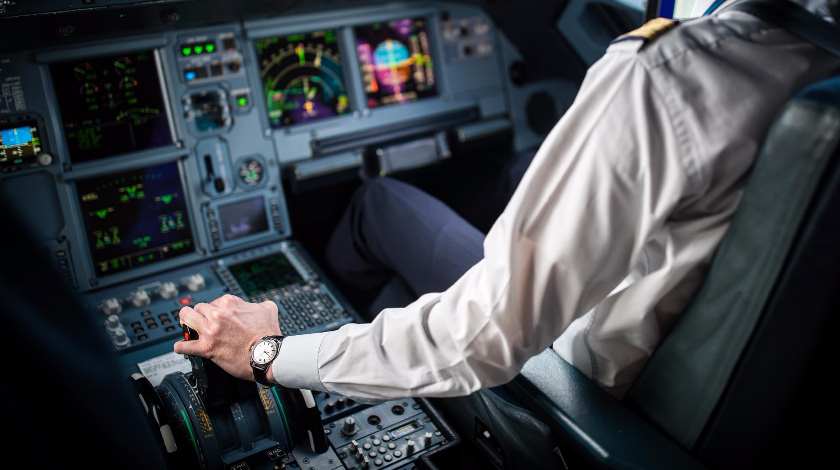Photo: shutterstock
Reading Time: 3 minutes116 years have passed since the first powered flight was performed by aviation pioneers the Wright brothers, who made the fixed-wing powered flight possible. Since then, aviation has developed into an enormous global industry with more than 225,000 daily flights (record beating number on July 24, 2019).
In 2018, 4.3 billion passengers flew safely on 46.1 million flights. Despite the extreme expansion, aviation is the safest type of public transport with continuous improvements in safety.
Human factor mistakes causing flight accidents are not new; however, it took a while for the market to take it into the spotlight. Therefore, aviation training is the backbone of the whole industry, aiming to prepare professionals able to operate at the highest level of safety.
Flight safety is a matter of all parties involved ─ regulatory institutions, including ICAO, EASA and FAA together with national CAA work hand in hand with each other to develop and adapt aviation training standards in different regions.
They initiate a different level of aviation regulation changes essential to keep and enhance the current level of flight safety. What are the on-going regulation updates changing pilot training related to flight safety?
Training Safety-Minded Pilots
Even though safety has always been number one priority in aviation, the perspective on how to ensure it is widening. Today aviation community escalates that a professional pilot not only knows how to control and navigate the aircraft, but also possesses a certain set of skills.
The skills that would allow a pilot to develop in a way that enables him to deal with unforeseen and unexpected situations inside the aircraft. To achieve that, various measures have been taken by the aviation community.
One of them is MPL training course. The MPL training course was introduced in 2006. Focusing on the 9 main competencies ─ communication, application of knowledge, leadership and teamwork, application of procedures and management of information, problem solving and decision making, situation awareness and work load management ─ it focuses on training a pilot not only under specific airline operations, but also developing these competencies in every step of the training.
Also, in 2018, EASA set the requirement to aviation training providers to add the non-technical skills training, called Area 100 KSA (Knowledge, Skills and Attitude) into its training syllabus until 2022.
This training course aims to help future pilots develop their decision-making abilities and their capacity to think under pressure, identify and correctly manage threats and errors, developing the right approach of looking into a problem in order to find a correct solution.
“Training highly-skilled aviation professionals is our goal. We believe, after completing this training module, students will be able to become not only more successful pilots but will also be more competitive on the market.
Area 100 KSA training course develops those pilot skills that are essential for a smooth communication during a flight, and that enable pilots to identify a problem and find the right solution,” says Aistė Dromantaitė, Educational Project Manager.
Train To Control Aircraft
Flight safety is primarily related to the pilot competencies to manage aircraft in high-risk situations when the flight altitude or airspeed of an aircraft is outside the normal bounds of operation for which it is designed.
“Aircraft upset” is a term that no one in aviation likes to hear when it is used to describe a real-world event. Situations like this require immediate corrective action and a position in which pilots do not want to find themselves.
That is, of course, unless they choose to do so intentionally, to experience it and learn how to respond best. Therefore, European Aviation Safety Agency has determined that pilots will have to undergo special Upset Prevention and Recovery Training (UPRT) to help them respond to unexpected situations to avoid situation known as Loss of Control In-flight (LOC-I). The regulation was launched on 8 April 2018, with a transition period of one year.
UPRT is a combination of theoretical knowledge and flight training to provide the flight crew with the required competencies to both prevent and recover from situations when an aircraft unintentionally exceeds the parameters for line operation or training (aircraft upsets).
This EASA regulation comes in 3 different levels of UPRT: Basic UPRT, Advanced UPRT course and class-or type-related UPRT for different training programs. This specialized type of training focuses on 4 key areas: Knowledge, Spatial orientation, Unusual attitude recovery and Spin recognition and recovery.
It is worth mentioning that UPRT regulations aren’t only about developing pilot competencies at Loss of Control In-flight situations. They have also brought new certification specifications for flight simulation training devices (CS-FSTD) recently updated to include guidance on stall model evaluation. This introduced a possibility of being confident that an FFS will adequately represent the characteristics of an aircraft during an aerodynamic stall.
Various aviation regulatory institutions publish different recommendations and launch new programs or update pilot training programs worldwide.
All of them are moving towards the same goal – to enhance the pilot‘s competencies and to raise the level of flight safety. Separate measures are taken to deal with safety risks of different level and all these regulatory activities turn aviation into one of the most regulated industries.

